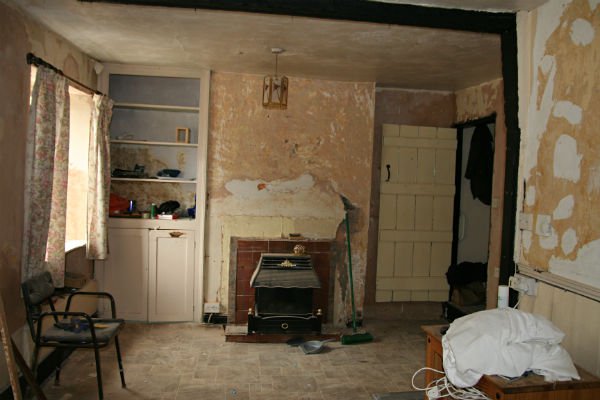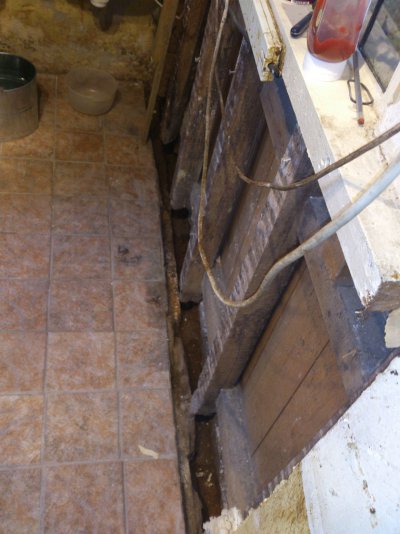Hello all,
First let me apologise if this has come up recently, I have checked back a few pages and couldnt see anything so bear with me...
We have just bought an old cottage, well actually two small workers cottages still separate inside, and are attempting to repair as much as we can traditionally and remove as much cement and concrete as possible!! Its rough stone built with semi-dressed limestone face and a rubble core, dated to anywhere from early 1700s to 1800. Any divides inside are lath and plaster, the floor is large flags. It is set into the hillside (garden about 12 ft above ground floor of house!) and built on bedrock so its pretty solid (though an old crack in one wall is evident after removing the gypsum plaster). Much of the original lime render is intact and seems solid, the many coats of limewash attest to it being looked after untill the 1930s when the fireplace was ripped apart and the use of cement started. Its a long job but we are doing most of it ourselves over the course of the coming months.
We need a couple of specialists though so thought we would ask here as we have had no joy googling for people!
First up... a drainage expert, used to dealing with odd drains (we seem to have a lot of them) going in strange directions (heading into a field) and a broken down soak-away put in rather crudely by the last occupant (who just painted over everything!!). We dont want someone who will try to rip everything up, but who understands old drains and their foibles!
Secondly...concrete render. Yes, most of the house is concrete rendered. We want to remove it but it seems pretty damn solid (took sledges to one area to test it...no joy). Is it a good idea in which case to leave it in place to avoid damaging the wall and wait for it to 'blow', or get a specialist in to take it all off the slow painfull way.
Where we can see the walls the original lime mortar is moderatly crumbly (pinkish with lime lumps) and in some places seems solid while in others their are gaps in the mortar leaving stone edges exposed. The wall around the top of the house is mostly loose!! Luckily the roof is fine (phew).
Luckily we don't seem to have much damp even with the concrete render and being set into the hill, and im hoping that taking all the plaster render off the inside will help. Original render and colour washes are still surviving behind the doors on a built-in cupboard beside the fireplace and it seems still good. Someone suggested tanking the back wall (against the hill, no gap) but I dont want to do this...I still think removing the modern render should help there as well, which is the only place we have any signs of real damp (black spotting).
So, can anyone help with a drainage specialist? Render removal advise? We are just south of Bristol so has anyone else used any experts around there we could call on?
All help very gratefully recieved indeed!! We do have the help of a vernacular building society hopefully for dating features like the panel divide (old post office in 1900) and a beam slot in the front room between the flags! I hope we can bring it back to life again, its a wonderfull little place.
First let me apologise if this has come up recently, I have checked back a few pages and couldnt see anything so bear with me...
We have just bought an old cottage, well actually two small workers cottages still separate inside, and are attempting to repair as much as we can traditionally and remove as much cement and concrete as possible!! Its rough stone built with semi-dressed limestone face and a rubble core, dated to anywhere from early 1700s to 1800. Any divides inside are lath and plaster, the floor is large flags. It is set into the hillside (garden about 12 ft above ground floor of house!) and built on bedrock so its pretty solid (though an old crack in one wall is evident after removing the gypsum plaster). Much of the original lime render is intact and seems solid, the many coats of limewash attest to it being looked after untill the 1930s when the fireplace was ripped apart and the use of cement started. Its a long job but we are doing most of it ourselves over the course of the coming months.
We need a couple of specialists though so thought we would ask here as we have had no joy googling for people!
First up... a drainage expert, used to dealing with odd drains (we seem to have a lot of them) going in strange directions (heading into a field) and a broken down soak-away put in rather crudely by the last occupant (who just painted over everything!!). We dont want someone who will try to rip everything up, but who understands old drains and their foibles!
Secondly...concrete render. Yes, most of the house is concrete rendered. We want to remove it but it seems pretty damn solid (took sledges to one area to test it...no joy). Is it a good idea in which case to leave it in place to avoid damaging the wall and wait for it to 'blow', or get a specialist in to take it all off the slow painfull way.
Where we can see the walls the original lime mortar is moderatly crumbly (pinkish with lime lumps) and in some places seems solid while in others their are gaps in the mortar leaving stone edges exposed. The wall around the top of the house is mostly loose!! Luckily the roof is fine (phew).
Luckily we don't seem to have much damp even with the concrete render and being set into the hill, and im hoping that taking all the plaster render off the inside will help. Original render and colour washes are still surviving behind the doors on a built-in cupboard beside the fireplace and it seems still good. Someone suggested tanking the back wall (against the hill, no gap) but I dont want to do this...I still think removing the modern render should help there as well, which is the only place we have any signs of real damp (black spotting).
So, can anyone help with a drainage specialist? Render removal advise? We are just south of Bristol so has anyone else used any experts around there we could call on?
All help very gratefully recieved indeed!! We do have the help of a vernacular building society hopefully for dating features like the panel divide (old post office in 1900) and a beam slot in the front room between the flags! I hope we can bring it back to life again, its a wonderfull little place.






